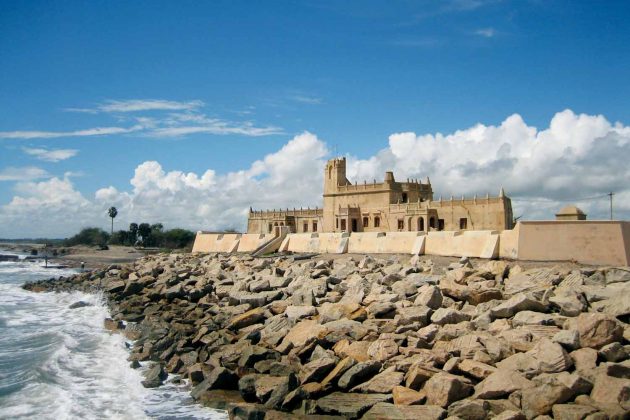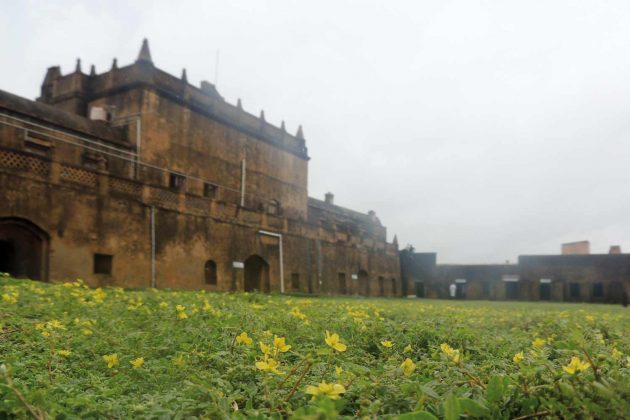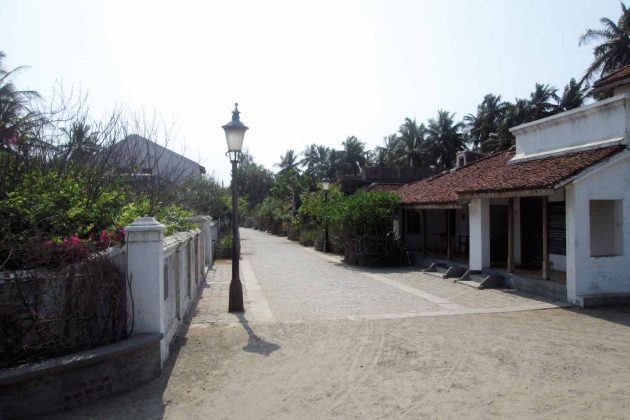Our train dropped us, early in the morning, at the rain-washed station of Mayiladuthurai. The rains were unexpected and we had no umbrellas. Leaving my son to take care of our luggage, I hurried to find a taxi that would take us to our destination. The drivers were huddling inside their vehicles, reluctant to step out. Eventually, one of them agreed and we made our way through the rain-drenched streets of the city to a small fishing village—Tharangambadi, along the Tamil Nadu coast.
Arriving in the sleepy fishing village
The little town of Tharangambadi was still fast asleep when we arrived. Only a few fishermen were visible, returning with their catch. The first indication that this was no ordinary fishing village came when we passed through the arc of the Town Gate. Restoration was in progress and it clearly pointed to a past era of grandeur and importance, much different from the sight it presented today.
The narrow road passed by old houses, churches and schools, and dropped us at the gates of another grand old structure, the former British governor’s bungalow, now a heritage hotel, the Bungalow on the Beach. While waiting for our room to be readied, we sat on easy-chairs on the veranda, enjoying the sight of the waves crashing on the shore, their roar reverberating through the silent beach. Complementing the waves was the rain that beat a rhythmic tapping on the roofs. The sea and the rain seemed to be playing a jugalbandi, and the effect was so melodious that I could guess why the early settlers had called this land Tharangambadi—the land of the singing waves!
Past glory of the Danes
Tharangambadi had become Trankebar with the arrival of the Danes in 1620. The Danish Admiral, Ove Gedde, had built a settlement here, the heart of which was Fort Dansborg. The central citadel, which is all that remains of the fort today, is typically European, a trapezoidal structure that faces the sea and has borne the brunt of its moods over the centuries. There is no sign of the moat that once surrounded the fort, and only traces of the walls that once protected it remain.
We had been eager to explore, but the fort’s caretaker was nowhere to be seen. Although when the rain subsided, he arrived and led us into a courtyard carpeted with tiny yellow flowers, from where the brownish-orange sandstone walls of Dansborg rose. From the top of the fort, we had a wonderful view of the sea and the village and it was almost like time had stood still.
For my son, it was a joyous adventure to walk on the partially submerged brick walls of the fort. For me, it was a scary escapade. As he stood there, the wind teasing his hair, his eyes rose to see a flock of flamingos flying past. I stood on the shore, ruminating about the rise and fall of fortunes.
On the shore, right outside the fort, stood a stone plaque commemorating the arrival of Bartholomaus Ziegenbalg and Heinrich Plutschau in 1706, the first Lutheran Missionaries to arrive in India. Both were zealous men of faith who spent years studying Tamil, understanding it, and becoming so fluent that they translated the Bible into Tamil! They also brought along a printing press to distribute copies of the translated Bible. The three churches in this tiny coastal village—Zion Church, New Jerusalem Church and the Lutheran Church—are testaments to the number of devotees the missionaries garnered.
Changing times
After the Danes, the British took over the village, even changing its name to Tranquebar. However, once India won her independence, and they were forced to leave, Tranquebar once again became Tharangambadi. Reflecting on the ever changing and cyclical nature of life, we headed next to explore another aspect of the town.
Dedicated to Lord Shiva as Masilamani Nathar—the unblemished one—the temple told us a story that was far older than the fort. Built during the reign of King Kulashekhara Pandyan I in the 14th century, the temple stands by the village shore, with the waves lapping at its steps. As we sat on the steps, our feet emersed in the water, we listened to an old priest tell us stories about the temple. He didn’t know of any legends or myths about the temple, but he told us it had great importance during the Pandya rule, when the village had been a busy port. Romans had come here, as had the Chinese. “There was a Chinese deity affixed atop the spire,” he insisted, “to draw more Chinese traders here”. We must have looked sceptical, for he added, “You ask them at the museum. They will tell you it is true.” As to where the idol was now, he had no idea. “It must have been washed away in the tsunami. Not the recent one, the one they say came centuries ago.”
This coast had been prone to nature’s fury, and a tsunami, centuries ago, was believed to have swept away the first temple built here. We know little of those times, but the tsunami of 2004 wrecked this coast and scarred monuments and humans alike.
Life in the village goes on
On that wet weekend in October, we were amongst the few tourists left in Tharangambadi. A young couple from Bangalore gave us company during mealtimes, and a few families dropped in to see the fort or play on the beach. “There are so few people here because of the rains,” rued the guard at the fort. We didn’t mind the rains though, and we enjoyed walking barefoot on the beach, revelling in the experience of having it all to ourselves.
The next morning, our last in Tharangambadi, we woke up early and walked down to an estuary where the river Manjaar merged with the Bay of Bengal. The shore was strewn with shells and we struggled to decide which ones to take back home with us. A fish, washed ashore by a wave, caught my son’s eye. Picking up one of the huge shells lying on the sand, he scooped up the fish and threw it back into the river. Never had I felt prouder!
As the sun rose, the crab fishermen arrived and began digging holes in the sand, deftly pulling the crabs that hid underneath. Then the fishermen came, returning with their day’s catch. The crows and kites followed the men closely, flying against the strong gusts of wind, and trying to grab any fish that escaped from he nets.
It was a simple moment, one that happened in every fishing village. Yet, it made me wonder, “Was it like this, before this town became a trading port? Before great powers caught the sight of this land?” The land and its people have been through so much, experiencing nature’s fury as well as bounty. They have known times that were joyous as well as tumultuous. Whether the tourists come to see the church’s spire towering high, or the temple with its steps leading into the waters, there is one thing for sure—humanity endures, and there is always hope!
Photo credits:
- Tharangambadi village: Licensed under [CC BY-SA 3.0] from Eagersnap [Wikimedia Commons]
- Fort Dansborg built by the Danes: Anuradha Shankar
- A view of Goldsmith street in the early morning hours: Licensed under [CC BY-SA 3.0] from Mukulfaiz [Wikimedia Commons]
- Masilamani Nathar temple built during the 14th century: Anuradha Shankar
- New Jerusalem Church, one of the three churches in this village: Licensed under [CC BY-SA 3.0] from Chenthil [Wikimedia Commons]






